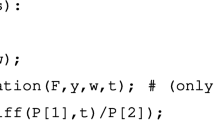Abstract
In this paper, the classical Lie group method is employed to obtain exact solutions for a nonlinear partial differential equation (NLPDE) derived from the reduced quasi-classical self-dual Yang–Mills equation. An infinite-dimensional Lie algebra is obtained, and by utilizing a seven-dimensional subspace of this algebra, the commutator table and adjoint representation table are constructed. These tables facilitate the construction of the optimal system for the equation, leading to precise solutions. The obtained solutions are presented graphically, accompanied by a suitable analysis.





Similar content being viewed by others
Data Availability Statement
No Data associated in the manuscript.
References
S.V. Manakov, P.M. Santini, Inverse scattering problem for vector fields and the Cauchy problem for the heavenly equation. Phys. Lett. A 359(6), 613–619 (2006)
M.J. Ablowitz, P.A. Clarkson, Solitons, nonlinear evolution equations and inverse scattering, vol. 149 (Cambridge University Press, Cambridge, 1991)
L. Lin, S.Y. Zhu, Y.K. Xu, Y.B. Shi, Exact solutions of Gardner equations through tanh–coth method. Appl. Math 7(18), 2374–2381 (2016)
W.X. Ma, Z.Y. Qin, X. Lü, Lump solutions to dimensionally reduced p-gKP and p-gBKP equations. Nonlinear Dyn. 84, 923–931 (2016)
E.G. Fan, H.Q. Zhang, A note on the homogeneous balance method. Phys. Lett. A 246(5), 403–406 (1998)
N.A. Kudryashov, On “new travelling wave solutions’’ of the KdV and the KdV-Burgers equations. Commun. Nonlinear Sci. Numer. Simul. 14(5), 1891–1900 (2009)
B. Ren, Symmetry reduction related with nonlocal symmetry for Gardner equation. Commun. Nonlinear Sci. Numer. Simul. 42, 456–463 (2017)
A.H. Chen, Multi-kink solutions and soliton fission and fusion of Sharma–Tasso–Olver equation. Phys. Lett. A 374(23), 2340–2345 (2010)
D. Daghan, O. Donmez, Exact solutions of the Gardner equation and their applications to the different physical plasmas. Brazilian J. Phys. 46, 321–333 (2016)
P.J. Olver, Applications of Lie groups to differential equations, vol. 107 (Springer, Berlin, 1993)
N. Benoudina, Y. Zhang, C.M. Khalique, Lie symmetry analysis, optimal system, new solitary wave solutions and conservation laws of the Pavlov equation. Commun. Nonlinear Sci. Num. Simul. 94, 105560 (2021)
S. Kumar, D. Kumar, A. Kumar, Lie symmetry analysis for obtaining the abundant exact solutions, optimal system and dynamics of solitons for a higher-dimensional Fokas equation. Chaos, Solitons & Fractals 142, 110507 (2021)
S. Kumar, W.X. Ma, S.K. Dhiman, A. Chauhan, Lie group analysis with the optimal system, generalized invariant solutions, and an enormous variety of different wave profiles for the higher-dimensional modified dispersive water wave system of equations. Eur. Phys. J. Plus 138(5), 434 (2023)
O.I. Morozov, Isospectral deformation of the reduced quasi-classical self-dual Yang–Mills equation. Differ. Geom. Appl. 76, 101742 (2021)
J. Jahnova, P. Vojcak, On recursion operators for full-fledged nonlocal symmetries of the reduced quasi-classical self-dual Yang–Mills equation. arXiv preprint arXiv:2310.11194, 2023
E.V. Ferapontov, K.R. Khusnutdinova, Hydrodynamic reductions of multidimensional dispersionless PDEs: the test for integrability. J. Math. Phys. 45(6), 2365–2377 (2004)
I.S. Krasil’shchik, O.I. Morozov, Lagrangian extensions of multi-dimensional integrable equations. i, the five-dimensional Martínez Alonso–Shabat equation. Analysis and Mathematical Physics, 13(1):2, 2023
O.I. Morozov, Lax representations with non-removable parameters and integrable hierarchies of PDEs via exotic cohomology of symmetry algebras. J. Geom. Phys. 143, 150–163 (2019)
B. Doubrov, E.V. Ferapontov, B. Kruglikov, V.S. Novikov, On integrability in Grassmann geometries: integrable systems associated with fourfolds in Gr (3, 5). Proc. Lond. Math. Soc. 116(5), 1269–1300 (2018)
R. Harvey, H.B. Lawson. Calibrated geometries. 1982
M. Dunajski, L.J. Mason, P. Tod, Einstein-Weyl geometry, the dKp equation and twistor theory. J. Geom. Phys. 37(1–2), 63–93 (2001)
J.F. Plebanski, Some solutions of complex Einstein equations. J. Math. Phys. 16(12), 2395–2402 (1975)
X.R. Hu, Y.Q. Li, Y. Chen, A direct algorithm of one-dimensional optimal system for the group invariant solutions. J. Math. Phys. 56(5), 053504 (2015)
Acknowledgements
This work was supported by the National Natural Science Foundation of China (Nos. 12201325, 12235007).
Author information
Authors and Affiliations
Corresponding author
Rights and permissions
Springer Nature or its licensor (e.g. a society or other partner) holds exclusive rights to this article under a publishing agreement with the author(s) or other rightsholder(s); author self-archiving of the accepted manuscript version of this article is solely governed by the terms of such publishing agreement and applicable law.
About this article
Cite this article
Zhang, X., Wang, B. Lie symmetry analysis, optimal system and exact solutions for a NLPDE from the reduced quasi-classical self-dual Yang–Mills equation. Eur. Phys. J. Plus 139, 329 (2024). https://doi.org/10.1140/epjp/s13360-024-05131-0
Received:
Accepted:
Published:
DOI: https://doi.org/10.1140/epjp/s13360-024-05131-0



